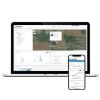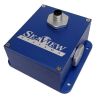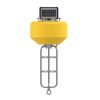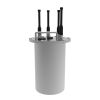NexSens CB-75-SVS Wave Buoy
Features
- Measures wave height, period & direction
- Designed for tethered moorings
- Integrated SeaView Systems SVS-603HR wave sensor
- Expedited repair and warranty service
- Lifetime technical support
- More
The CB-75-SVS Wave Buoy offers the latest in real-time wave observations in a compact, affordable, and easy to deploy platform. At 21” (53.34cm) hull diameter and 40 lb. (18.14kg) weight, it’s ideally suited for tethered moorings. The buoy accurately measures wave height, period, direction, and more using SeaView Systems’ industry-leading SVS-603HR sensor, relied upon in buoy networks by NOAA and many others throughout the world. External sensor ports with wet-mate connectors support GPS, meteorological, and water quality sensors for maximum flexibility.
The buoy is constructed of an inner core of cross-linked polyethylene foam with a tough polyurea skin. A rechargeable battery with integrated solar panels powers the wave buoy continuously, and all electronics are housed in a quick-removable waterproof package with wet-mate connectors. A removeable instrument cage serves as counter-ballast and supports instrument mounting, while three 1.5” (3.81cm) pass-through holes facilitate cable routing of underwater sensors.
Available with integrated Wi-Fi, 4G LTE or Iridium satellite communications, the CB-75-SVS Wave Buoy sends data in real-time to the cloud-based WQData LIVE datacenter. In the Basic tier, this free service allows users to securely access and analyze data, as well as share data through an auto-report. Subscription-based tiers of WQData LIVE are also available for generating custom alarms, exporting data through an API or custom NDBC/GLOS formats, and providing a publicly-accessible version of the project website.
Wave Sensor: SeaView Systems SVS-603HRi
Parameters: Hs Wave Height (Significant Wave Height), TP (DPD) Wave Period, Dominant Wave Direction, Mean Wave Direction (MWD), Te Energy Period, RMS Tilt Angle, Max Tilt Angle
Range: Wave Height: 0.2-20m; Wave Period: 1.5-20 seconds; Wave Direction: 0-360°
Resolution: Wave Height: 0.001m; Wave Period: 0.001 seconds; Wave Direction: 0.001°
Accuracy: Wave Height: +/- 0.5cm; Wave Period: <1%; Wave Direction: +/-2°
Buoy: NexSens CB-75
Hull Outer Diameter: 21” (53.34cm)
Hull Height: 13” (33.02cm)
Tower Height: 8.2” (20.83cm)
Solar Panels: 3x 4-watts
Weight: 40 lb. (18.20kg)
Net Buoyancy: 75 lb. (34.00kg)
Tethering Attachments: 3x 3/8” eye nuts
Data Logger: NexSens X3-SVS
Operating Temperature: -40°C to 70°C
Rating: IP68
User Interface: Wireless Bluetooth or wired RS-485 via USB adapter to CONNECT Software; WQData LIVE Web Datacenter with optional wireless telemetry; Status beeps
Real Time Clock (RTC): <30sec/month drift1; Auto-sync weekly2; Internal backup battery
Data Logging: 8 MB non-volatile flash memory; >1 year storage with 20 parameters at 15-minute interval; Max 200 parameters per log interval (170 parameters per instrument)
Log Interval: User configurable (30-minute default minimum)3; Unique interval per sensor
Transmit Interval: User configurable (60-minute default minimum)
Transmission Trigger: Time-based; Selective parameter upload option
Sensor Interfaces: RS-232 (2 Channels), SDI-12, RS-485, Pulse Count
Built-in Sensors: Temperature (-40° to 100°C, 0.016°C resolution, ±0.3°C accuracy); Humidity (0% to 100%, 0.03% resolution, ±4% accuracy from 5 to 95% RH; System voltage; System current; System power; Real-time clock (RTC) battery voltage
Sensor Ports: (2) MCBH-8-MP for sensor interface (RS-232, RS-485, SDI-12, Power, GND)
Power Port: (1) MCBH-6-FS for power and communication (12V Solar In, Power Switch, RS-485 Host, GND)
Telemetry Options: 2.4GHz Wi-Fi (802.11 b/g/n), 4G LTE global cellular, Iridium satellite; includes fallback support
Antenna Port: Type N female
Notes
1Assumes 25ºC operating temperature
2Requires the X3-SVS to be connected to the internet
3Minimum log interval dependent on wave sensor sampling frequency (5-minute, 10-minute, or 20-minute sample duration)
In The News
Protecting Chicago's Lakefront: Freshwater Beach Monitoring
Thousands of people flock to the Great Lakes every year to enjoy the freshwater beaches along the coast. As an urban hub with over 2.5 million residents, beachfronts in Chicago have regular visitors as well as tourists that recreate in the bordering Lake Michigan. According to the Chicago Park District, it is estimated that more than 100,000 residents and visitors per day use Chicago’s Lakefront trail during summer weekends. Proximity to the Lake is not only a recreational activity for Chicagoans, but also a part of the city’s history due to its role in domestic and international shipping routes. In addition, the Lake serves as a drinking water source and as an essential climate regulator in the region that acts as a natural air conditioning affect.
Read MoreThree Decades of Research at Acton Lake
A multi-disciplinary team at Miami University, Ohio, has been studying the environmental change at Acton Lake for over three decades. Using three different NexSens buoys over this time, the team has an incredible archive of data that is helping build a picture of Acton’s past, present, and future. Until recently, a NexSens CB-50 buoy was used alongside other environmental monitoring at Acton Lake. In May 2025, the Miami team deployed a new XB-200 buoy , future-proofing their ongoing monitoring using real-time buoy systems. Acton Lake, a small hypereutrophic reservoir in southwest Ohio, covers 2.4km² and has a maximum depth of about 8m. The dam was built in 1956, and the lake has a large agricultural watershed.
Read MoreSource Water Monitoring in Albany, New York: Tracing Water Quality throughout Tributaries
Thousands of US cities pull their drinking water from natural source waters like reservoirs, rivers, and streams, making overall watershed health a key consideration for water providers. In Albany, New York, the Albany Department of Water and Water Supply delivers drinking water to over 100,000 residents as well as monitors and manages the larger drinking water supply watershed. Hannah Doherty, Environmental Specialist at the Albany Department of Water and Water Supply , spends her days working with a small team to monitor the drinking supply and the connected water bodies. Doherty explains, “We’re the first to encounter the water that ends up being the drinking water.
Read More






















